Finance Report: Financial Analysis of Present Value, Bonds and Equity
VerifiedAdded on 2020/07/22
|9
|1112
|60
Report
AI Summary
This finance report provides a comprehensive analysis of various financial concepts. It begins with the calculation of present value under different scenarios, demonstrating how discount rates impact future values. The report then delves into bond valuation, exploring the relationship between yield to maturity (YTM) and bond prices, as well as the calculation of YTM. Furthermore, the report covers equity valuation, including the determination of the required rate of return and the value of shares based on dividends and growth rates. Finally, the report compares the characteristics of bonds and equity, highlighting their differences in terms of priority during liquidation, voting rights, risk, and maturity time. The conclusion emphasizes the importance of selecting appropriate financing sources based on specific business needs and market conditions.

FINANCE AND VALUE
Paraphrase This Document
Need a fresh take? Get an instant paraphrase of this document with our AI Paraphraser
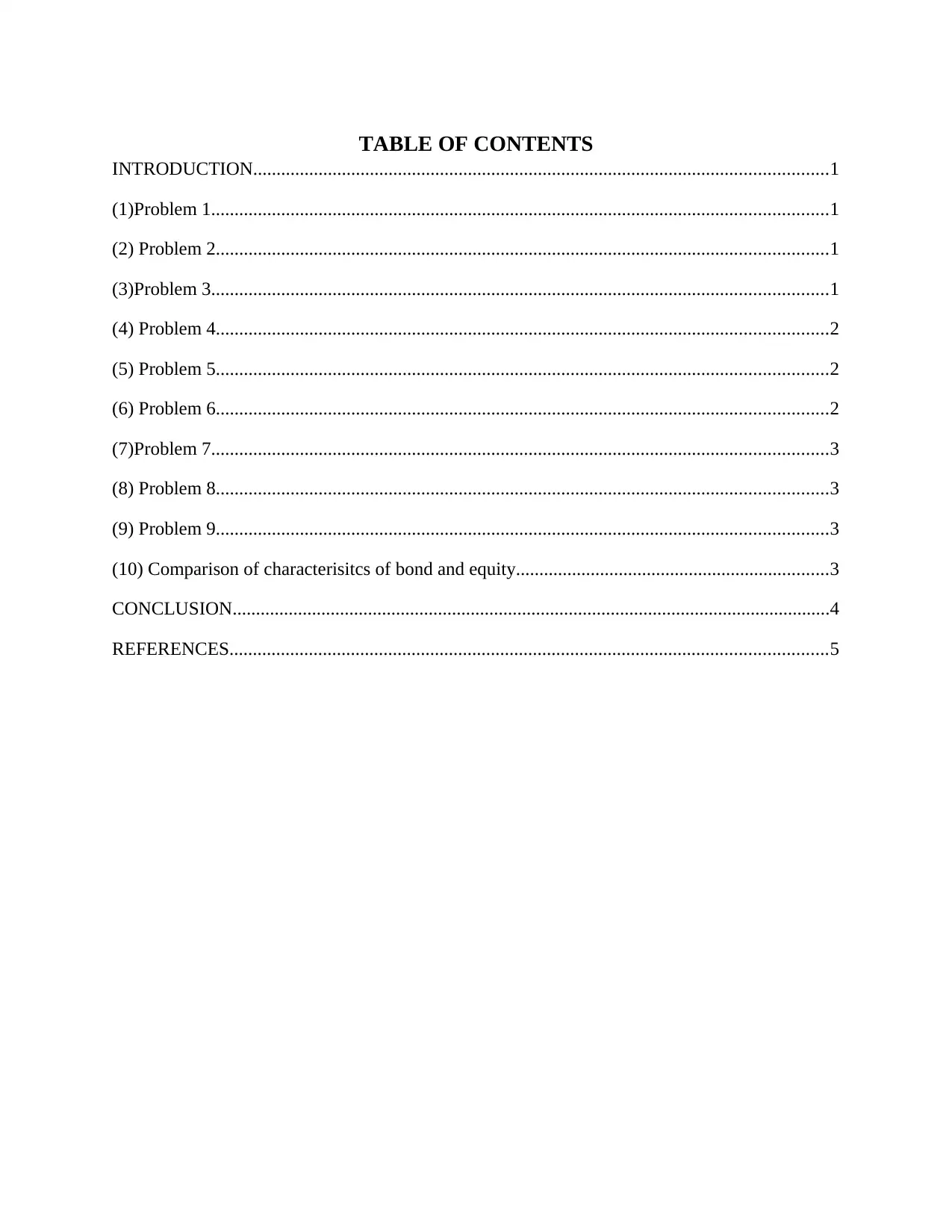
TABLE OF CONTENTS
INTRODUCTION...........................................................................................................................1
(1)Problem 1....................................................................................................................................1
(2) Problem 2...................................................................................................................................1
(3)Problem 3....................................................................................................................................1
(4) Problem 4...................................................................................................................................2
(5) Problem 5...................................................................................................................................2
(6) Problem 6...................................................................................................................................2
(7)Problem 7....................................................................................................................................3
(8) Problem 8...................................................................................................................................3
(9) Problem 9...................................................................................................................................3
(10) Comparison of characterisitcs of bond and equity...................................................................3
CONCLUSION................................................................................................................................4
REFERENCES................................................................................................................................5
INTRODUCTION...........................................................................................................................1
(1)Problem 1....................................................................................................................................1
(2) Problem 2...................................................................................................................................1
(3)Problem 3....................................................................................................................................1
(4) Problem 4...................................................................................................................................2
(5) Problem 5...................................................................................................................................2
(6) Problem 6...................................................................................................................................2
(7)Problem 7....................................................................................................................................3
(8) Problem 8...................................................................................................................................3
(9) Problem 9...................................................................................................................................3
(10) Comparison of characterisitcs of bond and equity...................................................................3
CONCLUSION................................................................................................................................4
REFERENCES................................................................................................................................5
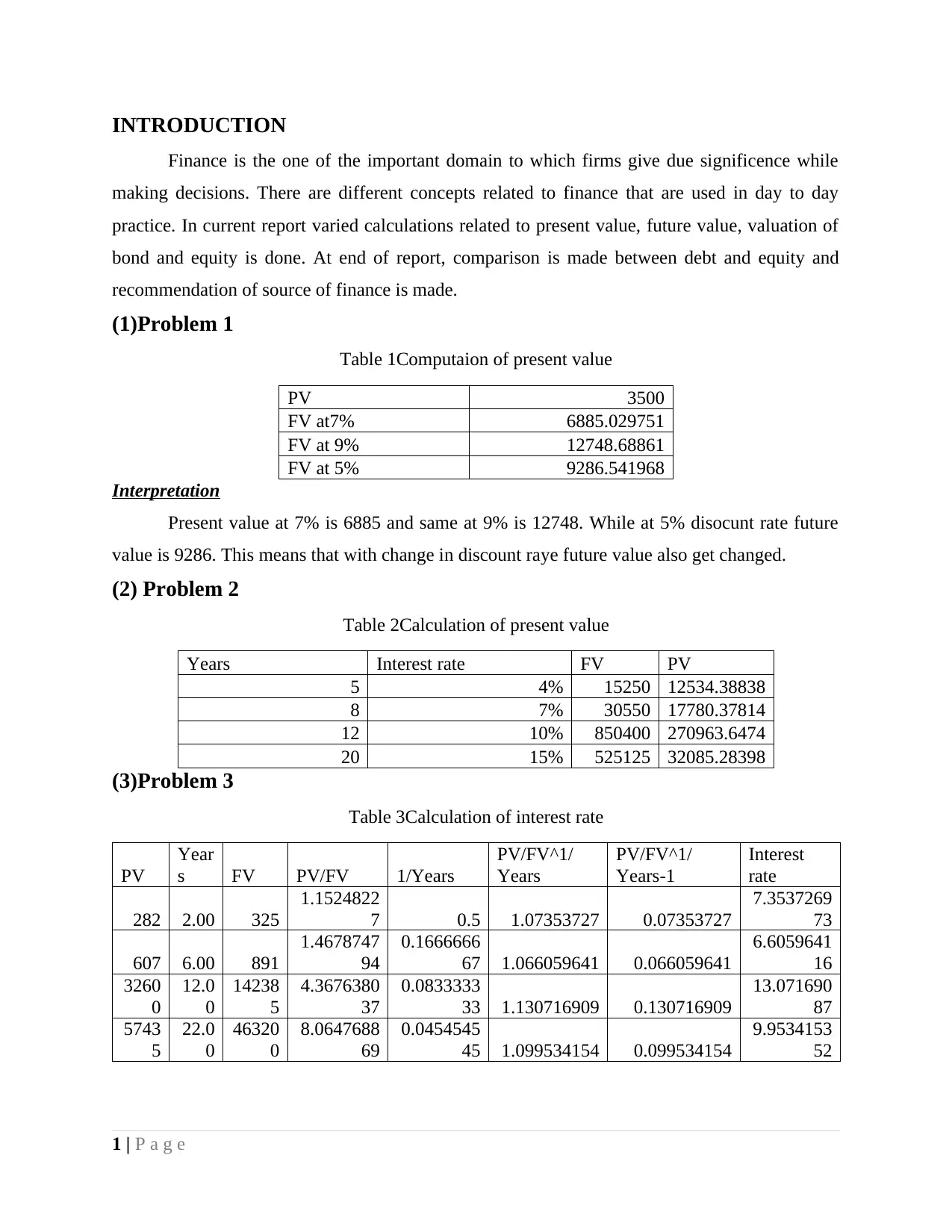
INTRODUCTION
Finance is the one of the important domain to which firms give due significence while
making decisions. There are different concepts related to finance that are used in day to day
practice. In current report varied calculations related to present value, future value, valuation of
bond and equity is done. At end of report, comparison is made between debt and equity and
recommendation of source of finance is made.
(1)Problem 1
Table 1Computaion of present value
PV 3500
FV at7% 6885.029751
FV at 9% 12748.68861
FV at 5% 9286.541968
Interpretation
Present value at 7% is 6885 and same at 9% is 12748. While at 5% disocunt rate future
value is 9286. This means that with change in discount raye future value also get changed.
(2) Problem 2
Table 2Calculation of present value
Years Interest rate FV PV
5 4% 15250 12534.38838
8 7% 30550 17780.37814
12 10% 850400 270963.6474
20 15% 525125 32085.28398
(3)Problem 3
Table 3Calculation of interest rate
PV
Year
s FV PV/FV 1/Years
PV/FV^1/
Years
PV/FV^1/
Years-1
Interest
rate
282 2.00 325
1.1524822
7 0.5 1.07353727 0.07353727
7.3537269
73
607 6.00 891
1.4678747
94
0.1666666
67 1.066059641 0.066059641
6.6059641
16
3260
0
12.0
0
14238
5
4.3676380
37
0.0833333
33 1.130716909 0.130716909
13.071690
87
5743
5
22.0
0
46320
0
8.0647688
69
0.0454545
45 1.099534154 0.099534154
9.9534153
52
1 | P a g e
Finance is the one of the important domain to which firms give due significence while
making decisions. There are different concepts related to finance that are used in day to day
practice. In current report varied calculations related to present value, future value, valuation of
bond and equity is done. At end of report, comparison is made between debt and equity and
recommendation of source of finance is made.
(1)Problem 1
Table 1Computaion of present value
PV 3500
FV at7% 6885.029751
FV at 9% 12748.68861
FV at 5% 9286.541968
Interpretation
Present value at 7% is 6885 and same at 9% is 12748. While at 5% disocunt rate future
value is 9286. This means that with change in discount raye future value also get changed.
(2) Problem 2
Table 2Calculation of present value
Years Interest rate FV PV
5 4% 15250 12534.38838
8 7% 30550 17780.37814
12 10% 850400 270963.6474
20 15% 525125 32085.28398
(3)Problem 3
Table 3Calculation of interest rate
PV
Year
s FV PV/FV 1/Years
PV/FV^1/
Years
PV/FV^1/
Years-1
Interest
rate
282 2.00 325
1.1524822
7 0.5 1.07353727 0.07353727
7.3537269
73
607 6.00 891
1.4678747
94
0.1666666
67 1.066059641 0.066059641
6.6059641
16
3260
0
12.0
0
14238
5
4.3676380
37
0.0833333
33 1.130716909 0.130716909
13.071690
87
5743
5
22.0
0
46320
0
8.0647688
69
0.0454545
45 1.099534154 0.099534154
9.9534153
52
1 | P a g e
⊘ This is a preview!⊘
Do you want full access?
Subscribe today to unlock all pages.

Trusted by 1+ million students worldwide
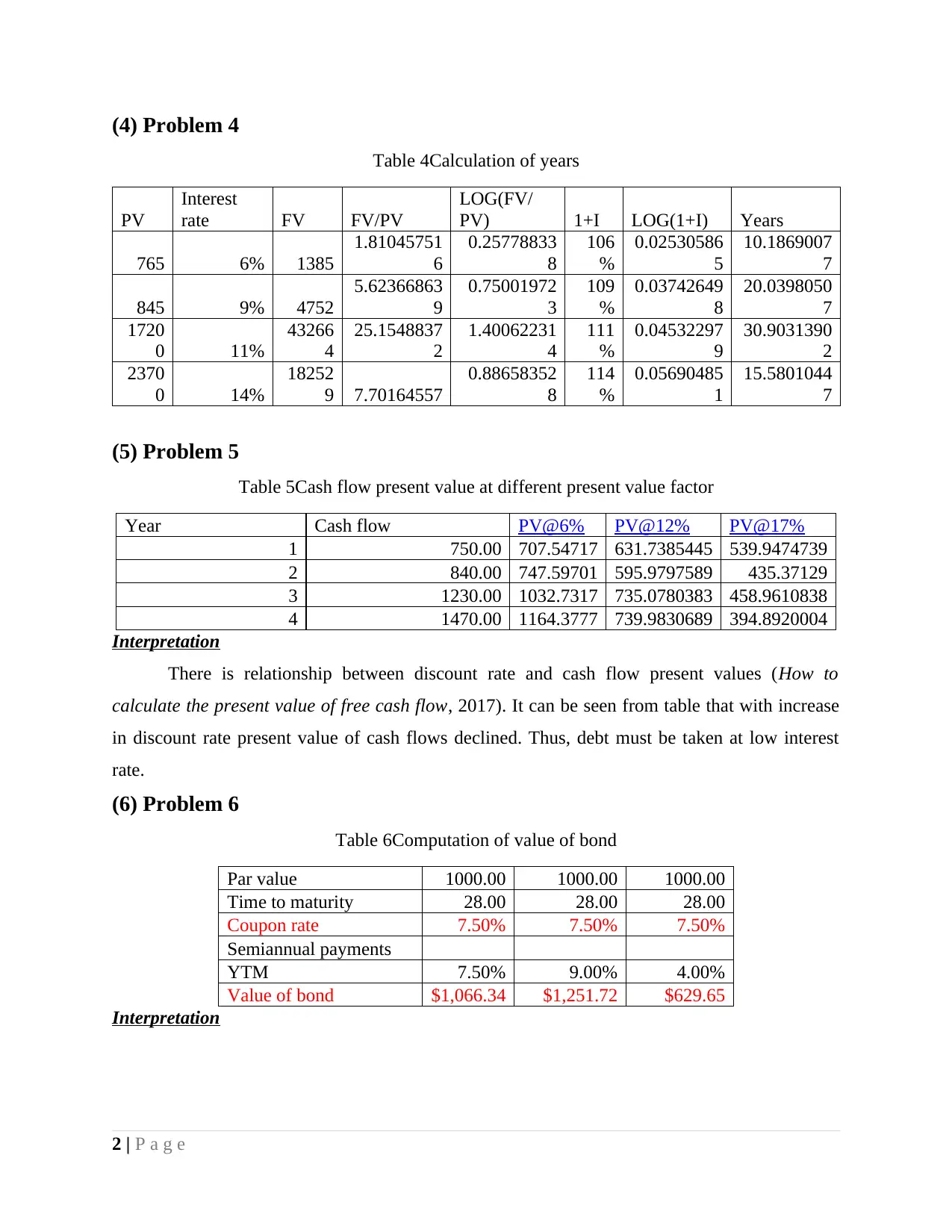
(4) Problem 4
Table 4Calculation of years
PV
Interest
rate FV FV/PV
LOG(FV/
PV) 1+I LOG(1+I) Years
765 6% 1385
1.81045751
6
0.25778833
8
106
%
0.02530586
5
10.1869007
7
845 9% 4752
5.62366863
9
0.75001972
3
109
%
0.03742649
8
20.0398050
7
1720
0 11%
43266
4
25.1548837
2
1.40062231
4
111
%
0.04532297
9
30.9031390
2
2370
0 14%
18252
9 7.70164557
0.88658352
8
114
%
0.05690485
1
15.5801044
7
(5) Problem 5
Table 5Cash flow present value at different present value factor
Year Cash flow PV@6% PV@12% PV@17%
1 750.00 707.54717 631.7385445 539.9474739
2 840.00 747.59701 595.9797589 435.37129
3 1230.00 1032.7317 735.0780383 458.9610838
4 1470.00 1164.3777 739.9830689 394.8920004
Interpretation
There is relationship between discount rate and cash flow present values (How to
calculate the present value of free cash flow, 2017). It can be seen from table that with increase
in discount rate present value of cash flows declined. Thus, debt must be taken at low interest
rate.
(6) Problem 6
Table 6Computation of value of bond
Par value 1000.00 1000.00 1000.00
Time to maturity 28.00 28.00 28.00
Coupon rate 7.50% 7.50% 7.50%
Semiannual payments
YTM 7.50% 9.00% 4.00%
Value of bond $1,066.34 $1,251.72 $629.65
Interpretation
2 | P a g e
Table 4Calculation of years
PV
Interest
rate FV FV/PV
LOG(FV/
PV) 1+I LOG(1+I) Years
765 6% 1385
1.81045751
6
0.25778833
8
106
%
0.02530586
5
10.1869007
7
845 9% 4752
5.62366863
9
0.75001972
3
109
%
0.03742649
8
20.0398050
7
1720
0 11%
43266
4
25.1548837
2
1.40062231
4
111
%
0.04532297
9
30.9031390
2
2370
0 14%
18252
9 7.70164557
0.88658352
8
114
%
0.05690485
1
15.5801044
7
(5) Problem 5
Table 5Cash flow present value at different present value factor
Year Cash flow PV@6% PV@12% PV@17%
1 750.00 707.54717 631.7385445 539.9474739
2 840.00 747.59701 595.9797589 435.37129
3 1230.00 1032.7317 735.0780383 458.9610838
4 1470.00 1164.3777 739.9830689 394.8920004
Interpretation
There is relationship between discount rate and cash flow present values (How to
calculate the present value of free cash flow, 2017). It can be seen from table that with increase
in discount rate present value of cash flows declined. Thus, debt must be taken at low interest
rate.
(6) Problem 6
Table 6Computation of value of bond
Par value 1000.00 1000.00 1000.00
Time to maturity 28.00 28.00 28.00
Coupon rate 7.50% 7.50% 7.50%
Semiannual payments
YTM 7.50% 9.00% 4.00%
Value of bond $1,066.34 $1,251.72 $629.65
Interpretation
2 | P a g e
Paraphrase This Document
Need a fresh take? Get an instant paraphrase of this document with our AI Paraphraser
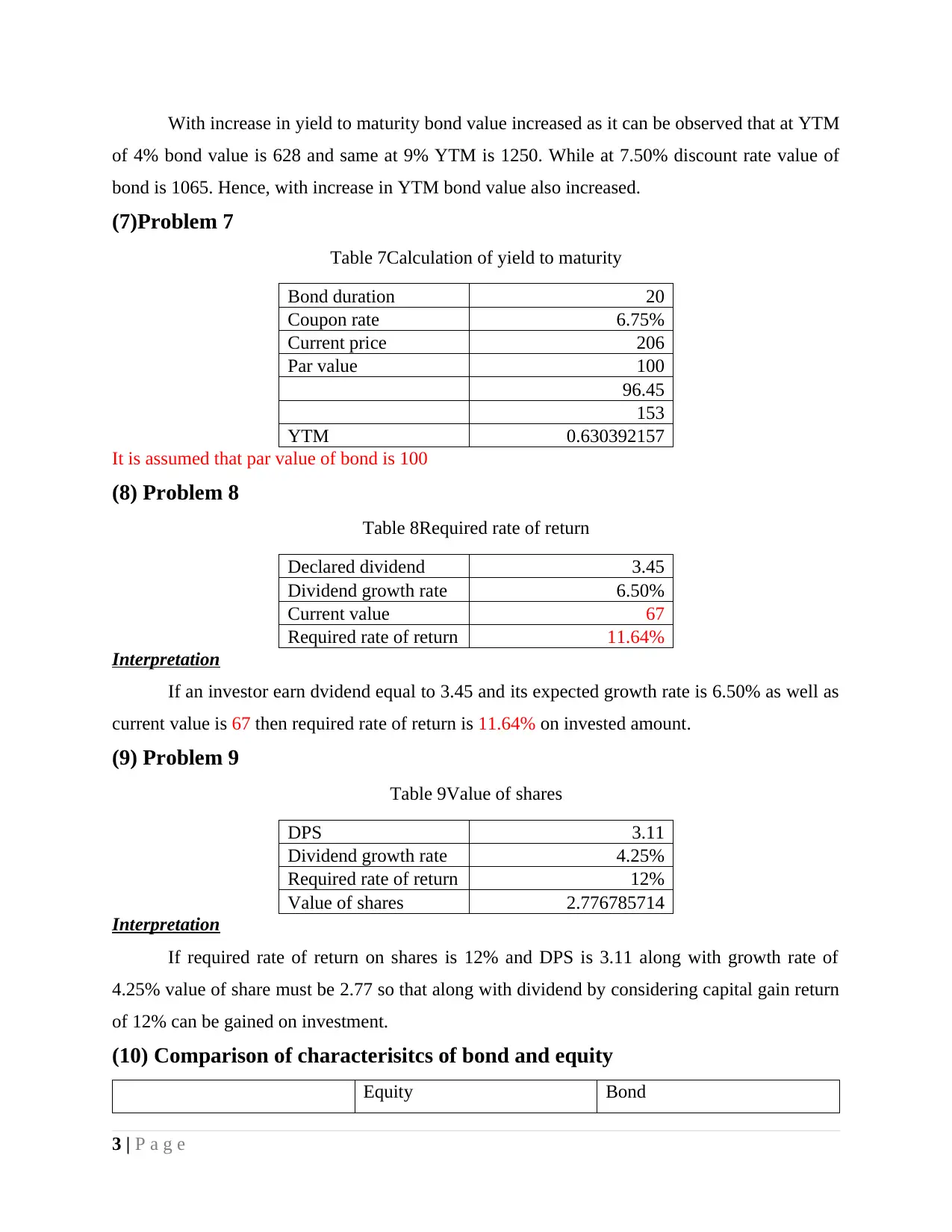
With increase in yield to maturity bond value increased as it can be observed that at YTM
of 4% bond value is 628 and same at 9% YTM is 1250. While at 7.50% discount rate value of
bond is 1065. Hence, with increase in YTM bond value also increased.
(7)Problem 7
Table 7Calculation of yield to maturity
Bond duration 20
Coupon rate 6.75%
Current price 206
Par value 100
96.45
153
YTM 0.630392157
It is assumed that par value of bond is 100
(8) Problem 8
Table 8Required rate of return
Declared dividend 3.45
Dividend growth rate 6.50%
Current value 67
Required rate of return 11.64%
Interpretation
If an investor earn dvidend equal to 3.45 and its expected growth rate is 6.50% as well as
current value is 67 then required rate of return is 11.64% on invested amount.
(9) Problem 9
Table 9Value of shares
DPS 3.11
Dividend growth rate 4.25%
Required rate of return 12%
Value of shares 2.776785714
Interpretation
If required rate of return on shares is 12% and DPS is 3.11 along with growth rate of
4.25% value of share must be 2.77 so that along with dividend by considering capital gain return
of 12% can be gained on investment.
(10) Comparison of characterisitcs of bond and equity
Equity Bond
3 | P a g e
of 4% bond value is 628 and same at 9% YTM is 1250. While at 7.50% discount rate value of
bond is 1065. Hence, with increase in YTM bond value also increased.
(7)Problem 7
Table 7Calculation of yield to maturity
Bond duration 20
Coupon rate 6.75%
Current price 206
Par value 100
96.45
153
YTM 0.630392157
It is assumed that par value of bond is 100
(8) Problem 8
Table 8Required rate of return
Declared dividend 3.45
Dividend growth rate 6.50%
Current value 67
Required rate of return 11.64%
Interpretation
If an investor earn dvidend equal to 3.45 and its expected growth rate is 6.50% as well as
current value is 67 then required rate of return is 11.64% on invested amount.
(9) Problem 9
Table 9Value of shares
DPS 3.11
Dividend growth rate 4.25%
Required rate of return 12%
Value of shares 2.776785714
Interpretation
If required rate of return on shares is 12% and DPS is 3.11 along with growth rate of
4.25% value of share must be 2.77 so that along with dividend by considering capital gain return
of 12% can be gained on investment.
(10) Comparison of characterisitcs of bond and equity
Equity Bond
3 | P a g e
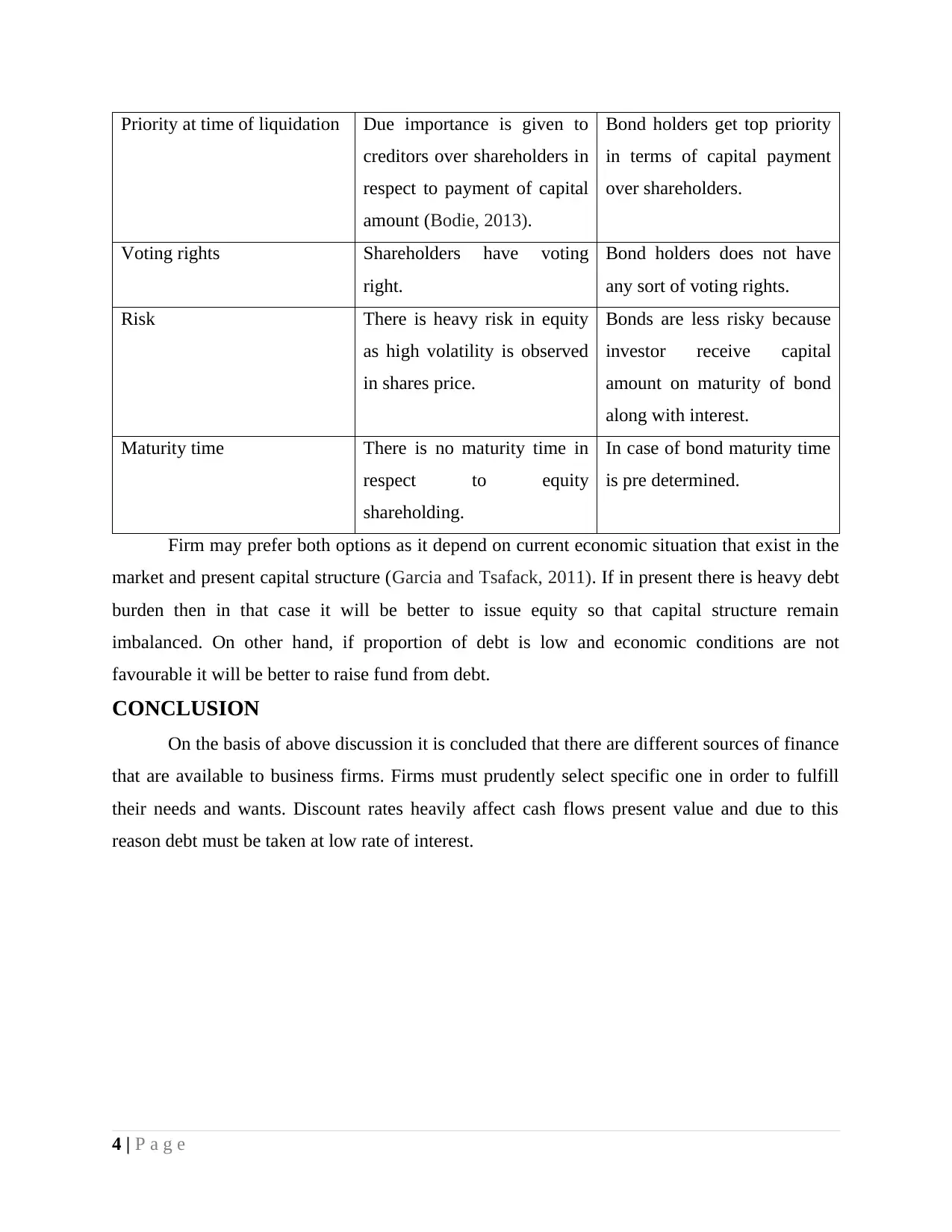
Priority at time of liquidation Due importance is given to
creditors over shareholders in
respect to payment of capital
amount (Bodie, 2013).
Bond holders get top priority
in terms of capital payment
over shareholders.
Voting rights Shareholders have voting
right.
Bond holders does not have
any sort of voting rights.
Risk There is heavy risk in equity
as high volatility is observed
in shares price.
Bonds are less risky because
investor receive capital
amount on maturity of bond
along with interest.
Maturity time There is no maturity time in
respect to equity
shareholding.
In case of bond maturity time
is pre determined.
Firm may prefer both options as it depend on current economic situation that exist in the
market and present capital structure (Garcia and Tsafack, 2011). If in present there is heavy debt
burden then in that case it will be better to issue equity so that capital structure remain
imbalanced. On other hand, if proportion of debt is low and economic conditions are not
favourable it will be better to raise fund from debt.
CONCLUSION
On the basis of above discussion it is concluded that there are different sources of finance
that are available to business firms. Firms must prudently select specific one in order to fulfill
their needs and wants. Discount rates heavily affect cash flows present value and due to this
reason debt must be taken at low rate of interest.
4 | P a g e
creditors over shareholders in
respect to payment of capital
amount (Bodie, 2013).
Bond holders get top priority
in terms of capital payment
over shareholders.
Voting rights Shareholders have voting
right.
Bond holders does not have
any sort of voting rights.
Risk There is heavy risk in equity
as high volatility is observed
in shares price.
Bonds are less risky because
investor receive capital
amount on maturity of bond
along with interest.
Maturity time There is no maturity time in
respect to equity
shareholding.
In case of bond maturity time
is pre determined.
Firm may prefer both options as it depend on current economic situation that exist in the
market and present capital structure (Garcia and Tsafack, 2011). If in present there is heavy debt
burden then in that case it will be better to issue equity so that capital structure remain
imbalanced. On other hand, if proportion of debt is low and economic conditions are not
favourable it will be better to raise fund from debt.
CONCLUSION
On the basis of above discussion it is concluded that there are different sources of finance
that are available to business firms. Firms must prudently select specific one in order to fulfill
their needs and wants. Discount rates heavily affect cash flows present value and due to this
reason debt must be taken at low rate of interest.
4 | P a g e
⊘ This is a preview!⊘
Do you want full access?
Subscribe today to unlock all pages.

Trusted by 1+ million students worldwide
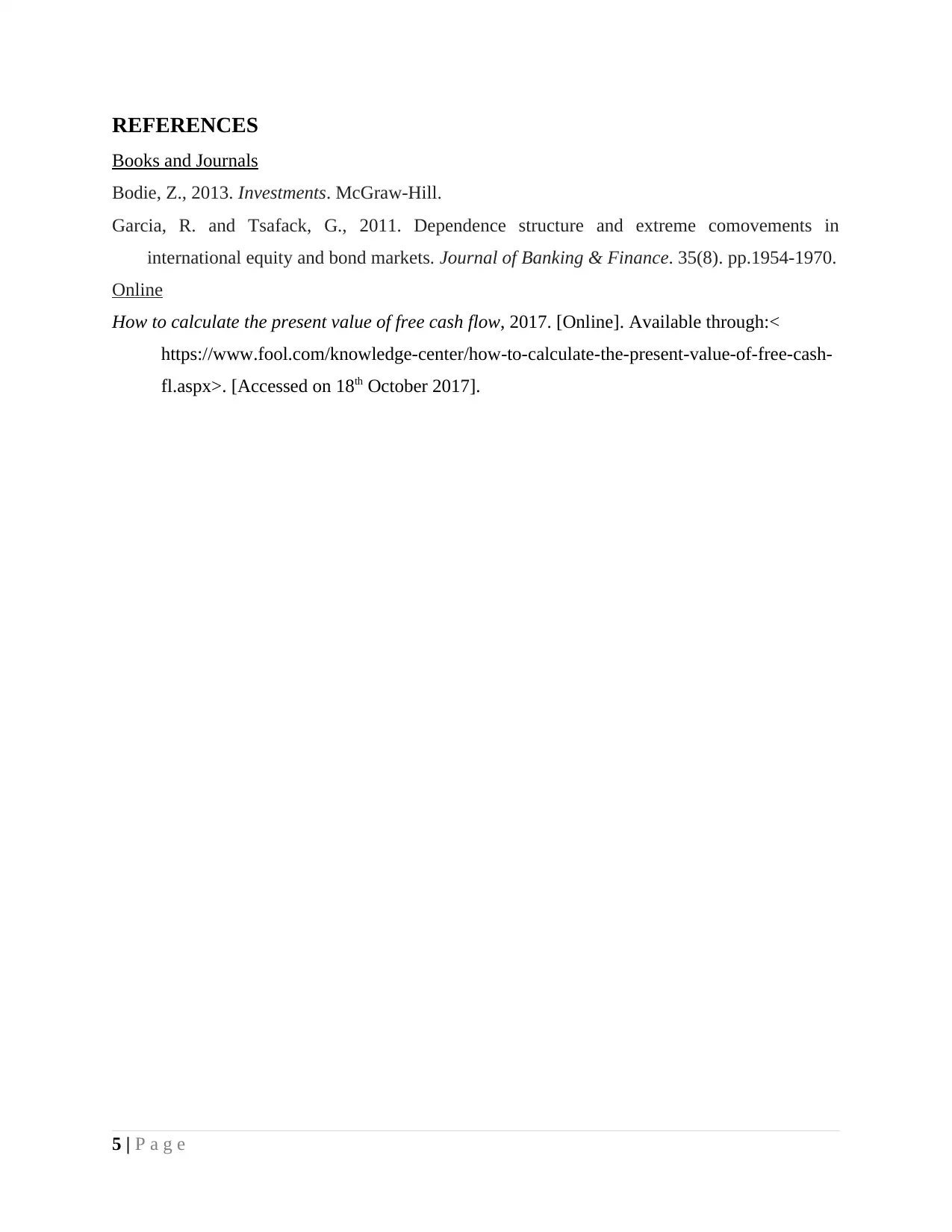
REFERENCES
Books and Journals
Bodie, Z., 2013. Investments. McGraw-Hill.
Garcia, R. and Tsafack, G., 2011. Dependence structure and extreme comovements in
international equity and bond markets. Journal of Banking & Finance. 35(8). pp.1954-1970.
Online
How to calculate the present value of free cash flow, 2017. [Online]. Available through:<
https://www.fool.com/knowledge-center/how-to-calculate-the-present-value-of-free-cash-
fl.aspx>. [Accessed on 18th October 2017].
5 | P a g e
Books and Journals
Bodie, Z., 2013. Investments. McGraw-Hill.
Garcia, R. and Tsafack, G., 2011. Dependence structure and extreme comovements in
international equity and bond markets. Journal of Banking & Finance. 35(8). pp.1954-1970.
Online
How to calculate the present value of free cash flow, 2017. [Online]. Available through:<
https://www.fool.com/knowledge-center/how-to-calculate-the-present-value-of-free-cash-
fl.aspx>. [Accessed on 18th October 2017].
5 | P a g e
Paraphrase This Document
Need a fresh take? Get an instant paraphrase of this document with our AI Paraphraser

6 | P a g e

7 | P a g e
⊘ This is a preview!⊘
Do you want full access?
Subscribe today to unlock all pages.

Trusted by 1+ million students worldwide
1 out of 9
Related Documents
Your All-in-One AI-Powered Toolkit for Academic Success.
+13062052269
info@desklib.com
Available 24*7 on WhatsApp / Email
![[object Object]](/_next/static/media/star-bottom.7253800d.svg)
Unlock your academic potential
Copyright © 2020–2025 A2Z Services. All Rights Reserved. Developed and managed by ZUCOL.





